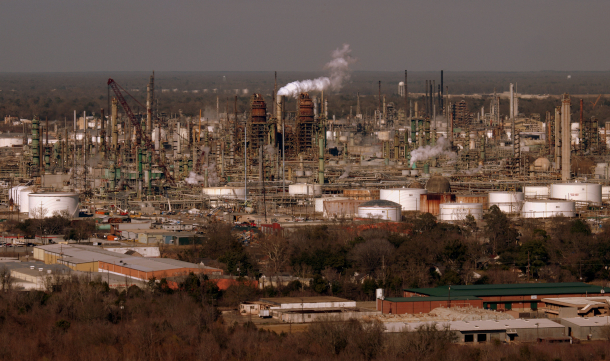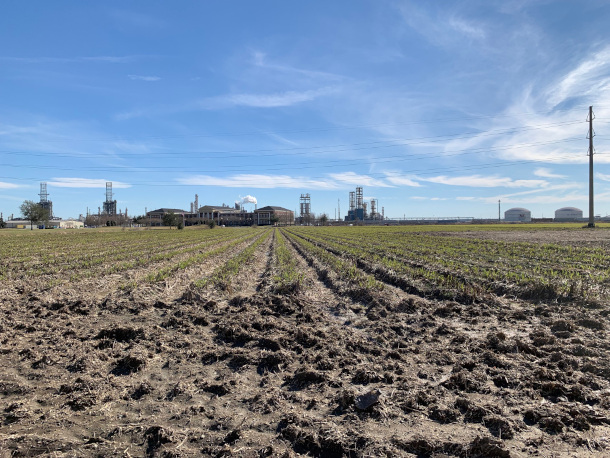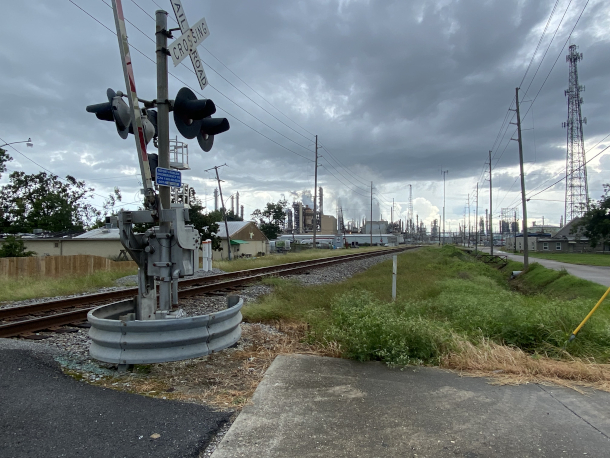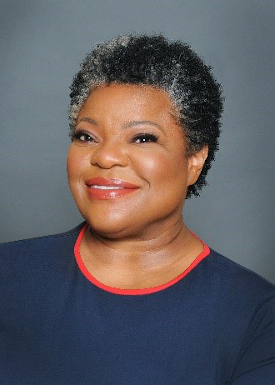Righting the Wrongs of Environmental Racism
Air Date: Week of April 7, 2023

ExxonMobil’s Baton Rouge Refinery along Louisiana’s “Cancer Alley.” (Photo: Jim Bowen, Flickr CC BY 2.0)
The Black residents of the heavily industrialized corridor along the Mississippi known as “Cancer Alley” have filed a civil rights and religious liberty lawsuit against the parish council that has given a green light to these polluting facilities for decades. Monique Harden of the Deep South Center for Environmental Justice joins Host Steve Curwood to explain the history of environmental racism and resistance in “Cancer Alley.”
Transcript
CURWOOD: The Black residents of the heavily industrialized corridor along the Mississippi in Louisiana known as “Cancer Alley” have been fighting for years to stop new petrochemical plants, but each battle has been a bit of a game of “whack-a-mole”. Now they’re bringing a civil rights and religious liberty case against a local government body that has given a green light to these polluting facilities for decades. The lawsuit alleges that the St. James Parish council has “intentionally chosen to locate over a dozen enormous industrial facilities in the majority Black fourth and fifth districts, while explicitly sparing white residents from the risk of environmental harm.” The suit seeks to enjoin the council from issuing any more industrial permits in black neighborhoods. Monique Harden is the Director of Law and Policy at the Deep South Center for Environmental Justice and joins me now from New Orleans. Welcome back to Living on Earth, Monique!
HARDEN: Hi, Steve, great to be back.
CURWOOD: Our pleasure. Now this case has a unique approach, at least to my eyes, because they're not selling on the basis of pollution exposure alone, but on the basis of systemic racism and discrimination going back since the first days of slavery on the sugarcane plantations there. What's the history of what happened there?
HARDEN: Well, this is a case that is novel but sorely needed in communities that have bared the burdens of legacy pollution that date back for generations. In St. James Parish, Black communities have borne the burdens and hazards of toxic pollution raining down on them from industrial facilities that were all approved without their say. This goes back to the 1940s in Jim Crow Louisiana, when Black residents in particular did not have the right to vote. And so issues around land use, zoning, how they would be represented, how decisions would be made around what would be developed in their environs was something that they were denied, brutally, in the South and here in Louisiana and in St. James Parish. So what this lawsuit sets out to do is really to remedy and correct that wrong that continues and persists to this very day.
CURWOOD: Now, in addition to being a civil rights and environmental justice lawsuit, this is also about religious liberty, according to the complaint from the plaintiffs. What's the basis for bringing the action on the grounds of religious freedom, and what are the laws there?
HARDEN: Well, the basis is that there's a law protecting the exercise of religious freedom and institutions. And what the facts show is that land use planning sets aside buffer zones to protect Catholic churches and places of worship from industrial development, but not the same for any other religious institution or place of worship in the parish.
CURWOOD: And of course, I gather the bulk of Black people there are not Catholic, they're Baptist, whereas probably the majority ethnicity of the Catholic churches there are white. How accurate is that perception?

Sugarcane fields in front of the Marathon Garyville refinery in St. John the Baptist Parish, adjacent to St. James Parish, Louisiana. Enslaved African Americans once toiled to grow sugarcane on plantations, and today petrochemical plants are replacing agriculture in the region. (Photo: Jenni Doering)
HARDEN: You will find Black Catholics throughout Louisiana, but the numbers are larger among white residents. More likely than not, it does follow mostly along racial lines, so that it's more likely that white Catholics would live next to Black Protestants, mostly Baptists, throughout the state.
CURWOOD: What's the role of the cemeteries along the Mississippi there? The cemeteries that, it's understood that people who were enslaved working the sugarcane plantations back in the day, are either already under factories or in places that factories want to build.
HARDEN: Or in places where the factories have control over the sites in terms of access to them. That's also the case here in Cancer Alley. This has only happened, right, because of the total lack of regard for Black people, Black communities, and Black burial places. Cemeteries of deceased Black residents of St. James Parish are not afforded the same protections, as the case for cemeteries where there are, white residents of the parish have been buried. So righting those wrongs is what's front and center of this lawsuit. You know, you're talking about places where people who have gone on and passed on, are relatives of folks living today and fighting for the places that they call home. And if you can take away a community cemetery, and you can take away their right to clean air, clean water, clean land, what's left? What's left? And so you see residents really fighting for a way of life that has never been protected by their parish government and trying to right that wrong.
CURWOOD: Please give me an example of what the plaintiffs say is discriminatory behavior by the planning boards there in that county when it comes to industrial plants.
HARDEN: It's real simple. The planning boards do not afford the same protection to Black communities in the parish as they do to white communities in the parish. So in the lawsuit, the plaintiffs discuss the St. James Parish planning Council's decision in an application that was brought by an industrial company called Wolverine Terminals. This Corporation had sought a land use approval from the St. James Parish Council, where they wanted to build a terminal for crude oil storage in a predominantly white part of St. James Parish, where residents were more than eighty percent white and just about thirteen percent black. That application was denied by the St. James Council, on the grounds that the company did not consider locating in a Black community in the parish.

Petrochemical plants near residential neighborhoods in “Cancer Alley” along the lower Mississippi River in Louisiana. (Photo: Courtesy of Deep South Center for Environmental Justice)
CURWOOD: So just blatant like that, huh?
HARDEN: Yes. You know, stepping into St. James Parish and looking around and driving around the community, it's, the landscape just exhibits that racial divide in terms of where industrial, you know, heavy polluting industrial facilities are able to locate and operate, in Black communities, and you don't see them in the white communities. And it's not to say that white communities should have them too. You know, our position at Deep South Center for Environmental Justice that no community should have it. But what we see in St. James Parish, what this lawsuit points out is that the discrimination is one where it forces all of the hazards and all of the health and safety risks and the denial of a sustainable future for Black communities in the hands of a parish council that makes decisions like this.
CURWOOD: Monique, why have environmental laws, like the Clean Air Act and the Clean Water Act, failed to get results when it comes to environmental justice?
HARDEN: Well, it's because they do not address the tremendous health concerns that communities, Black communities in St. James Parish, for example, have. Instead, the laws operate in accordance with equipment, devices, modes of processing and operations, that is already in existence within an industrial sector. So that if you own a company in a particular industrial sector that's regulated under the Clean Air Act, the only thing you have to do is meet the standard of peers within your industrial sector that are now codified in the regulations under the Clean Air Act. So you see how a community's demand around health and safety are not addressed in that kind of a framework.
CURWOOD: Now, a number of years ago, you won a case blocking a big company called Shintech from setting up a plant there. If the environmental laws like the Clean Air Act and Clean Water Act don't really address this, how are you able to succeed in that case?
HARDEN: Well, the case against Shintech that I brought along with lawyers and law students at Tulane Environmental Law Clinic focused on bringing in something outside of the Clean Air Act for the EPA to consider. And that was the then President Executive Order on Environmental Justice that called on EPA and other federal agencies and departments to prevent racially disproportionate pollution burdens. So our argument was that our state agency had drafted an air permit for the Shintech company in St. James Parish, back in 1996, that not only didn't comport with the legal requirements under the Clean Air Act, but it also would fail to ensure that the environmental justice called for in the executive order would be followed. And so you know, that landed on the desk of EPA Administrator Cal Browner, who made the right decision in finding that environmental justice is a priority for the agency, also agreeing with us on the numerous errors in how the permit was drafted that did, in fact, even violate those bare basic minimum requirements for that facility. And also doing another thing that was really unprecedented at that time, which was setting the EPA on a course for civil rights enforcement as a way to carry out the obligations of the agency has under the executive order on environmental justice. And so what we did in the Shintech case, in some ways, is similar to what's happening here in this lawsuit, which is going outside, beyond, those environmental legal requirements, because they really don't address the health and wellness and sustainability of a community, but instead looking for other support in law and policy.
CURWOOD: Monique, to what extent does the history of not just slavery, but later on Jim Crow, and the inability for many, I think almost all Black people couldn't vote until the Voting Rights Acts come along in the 60s. To what extent does the lack of the vote by people of color undergird this massive discrimination when it comes to putting polluting sites along the Mississippi?

Monique Harden is the Director of Law and Policy and Community Engagement Program Manager at the Deep South Center for Environmental Justice. (Photo: Courtesy of Deep South Center for Environmental Justice)
HARDEN: It's really central, Steve, because it was this denial of the right to vote and participation in decision making that affects your life, denied to Black residents across the South under Jim Crow system, that opened the door for oil refineries, gas production, chemical manufacturing, and now plastic production to come into so many places in the southern region where Black communities, Black people were able to settle and found and develop communities, places where hundreds of families could call home. And those places became targets for this kind of industrial development at a time when, of course, the residents didn't have a voice in even leveling a protest against it, let alone asking questions regarding it.
CURWOOD: So you've been involved in this kind of litigation and efforts to address environmental injustice for a number of years. What do you see the odds of this particular lawsuit moving forward, at least getting into the discovery phase where information will have to be revealed by this set of parish officials and planning councils?
HARDEN: I think the plaintiffs and their lawyers have really done a really good job of laying out how this particular parish government's decisions violate the rights of Black residents in the parish, and looking at the laws that protect those rights under the federal non discrimination laws, federal protections for the exercise of religious freedoms. And so in that way, it really brings together much of what the environmental justice movement is set on, which is protecting the rights of people to enjoy the places that they call home. And you can't enjoy the place you call home if your parish government is targeting you and bombarding you with one toxic facility after another.
CURWOOD: Monique Harden is the Director of Law and Policy and the Community Engagement Program Manager at the Deep South Center for Environmental Justice. Thank you so much for taking the time with us today.
HARDEN: Thank you for having me.
Links
Read the complaint against the St. James Parish Council
About the EPA’s 1997 Shintech decision citing environmental justice and civil rights
Listen to Living on Earth’s story about enslaved people buried in Louisiana’s “Cancer Alley”
Living on Earth wants to hear from you!
Living on Earth
62 Calef Highway, Suite 212
Lee, NH 03861
Telephone: 617-287-4121
E-mail: comments@loe.org
Newsletter [Click here]
Donate to Living on Earth!
Living on Earth is an independent media program and relies entirely on contributions from listeners and institutions supporting public service. Please donate now to preserve an independent environmental voice.
NewsletterLiving on Earth offers a weekly delivery of the show's rundown to your mailbox. Sign up for our newsletter today!
 Sailors For The Sea: Be the change you want to sea.
Sailors For The Sea: Be the change you want to sea.
 The Grantham Foundation for the Protection of the Environment: Committed to protecting and improving the health of the global environment.
The Grantham Foundation for the Protection of the Environment: Committed to protecting and improving the health of the global environment.
 Contribute to Living on Earth and receive, as our gift to you, an archival print of one of Mark Seth Lender's extraordinary wildlife photographs. Follow the link to see Mark's current collection of photographs.
Contribute to Living on Earth and receive, as our gift to you, an archival print of one of Mark Seth Lender's extraordinary wildlife photographs. Follow the link to see Mark's current collection of photographs.
 Buy a signed copy of Mark Seth Lender's book Smeagull the Seagull & support Living on Earth
Buy a signed copy of Mark Seth Lender's book Smeagull the Seagull & support Living on Earth

